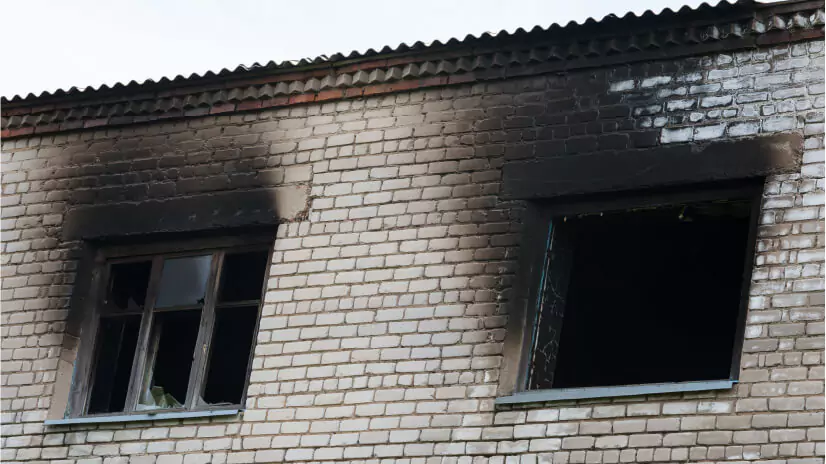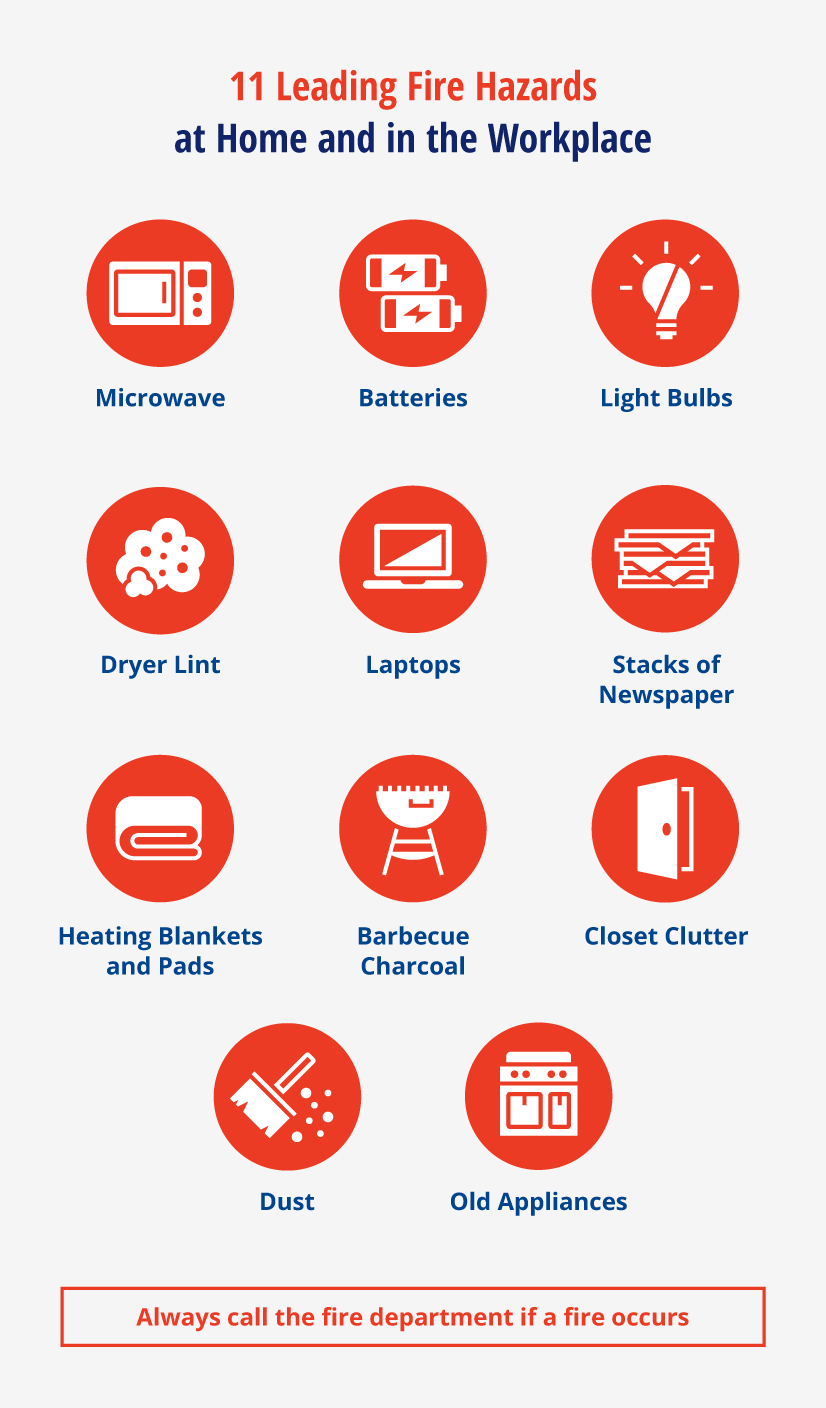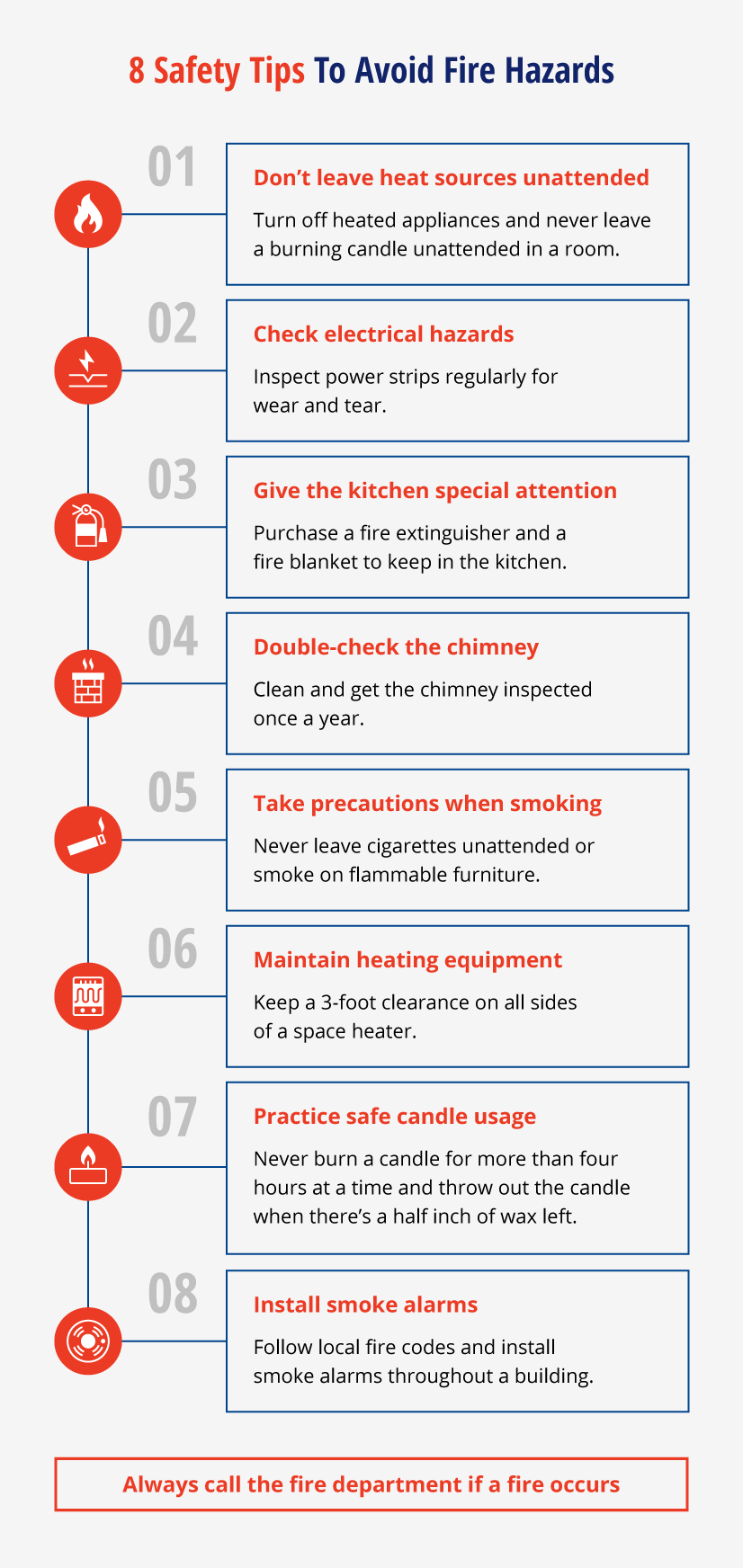
A fire hazard is anything that creates an increased risk of a fire. Common fire hazards include dryer lint, old appliances, batteries, and space heaters.
Everyone’s familiar with the surge of panic that happens if they hear a fire alarm — and hopefully, the relief of realizing the culprit is something as harmless as burnt toast.
Fire hazards are any materials or actions that can cause a fire, which can lead to extensive smoke damage, property loss, and even personal injury. According to FEMA, the lost value from fire damage has increased by 51% since 2012 –– making it more important than ever to learn how to identify fire hazards to protect a property and the people in it.
In this article, we’ll review some of the most common fire hazard materials, and provide prevention tips.
Fire Hazard Meaning
A fire hazard is anything — an item or activity — that frequently creates fires. For example, dryer lint is a fire hazard because it’s a very flammable material. Smoking indoors is also a fire hazard because it’s an action that can lead to a fire.
Fires need three things to start:
- Fuel
- Oxygen
- Heat
Any situation that combines these factors can pose a fire risk.
11 Common Fire Hazards
Most people know that overloaded electrical outlets or malfunctioning appliances are common household fire starters, but there are also a number of other everyday items that can create a fire hazard.

1. Microwaves
Microwaves offer a variety of fire risks. Unnoticed metals on dinnerware, takeout containers, and even in recycled paper products, can result in arcing, sparks, and fire.
Popcorn, a commonly microwaved item, can easily catch fire when cooked for too long. Always pay attention when you’re using the microwave, and watch out for warning signs like burning smells, smoke, or sparks.
Fire Prevention Tip: Microwaves are high voltage and pose an extreme fire risk when not properly operating. To prevent a microwave from turning into a fire hazard:
- Clean it regularly and use only materials designed for microwave use to reduce fire potential.
- If the microwave malfunctions, unplug it and replace it immediately.
- Never attempt to repair a microwave yourself; simply replace it or consult a professional.
Troubleshooting Tip: If there’s a microwave fire, turn it off immediately to prevent the fan from feeding oxygen to flames and call the fire department.
2. Batteries
All batteries pose a fire risk, even those with a weak charge. However, 9-volt batteries are the biggest culprit of fire due to the close proximity of their terminals, which can easily cause the battery to short circuit.
A battery storage case is highly recommended to avoid leaving batters lying around loose. Do not store batteries in metal containers or near other metal items such as keys, steel wool, or aluminum foil. Be sure to store 9-volt batteries separately.
Fire Prevention Tip: Store batteries standing upright, placing electrical tape over the ends of each battery (all types — not just 9 volts) to prevent shorts.
Troubleshooting Tip: Keep a Class C fire extinguisher around, and don’t try to use water to put out a battery fire.
3. Light Bulbs
Overlamping, or using a light bulb with a wattage that is too high for a given outlet, can easily result in a fire. Determining the right light bulb with proper wattage is easy. Simply locate the proper wattage on each fixture’s label.
Caution must also be taken with CFLs (compact fluorescents). These spiral-shaped bulbs could result in a fire when improperly used. Avoid using CFLs in any lighting unit where the base of the bulb is enclosed by the fixture, such as with track and recessed lighting. If CFLs are burning out early and brown at the base when removed, the bulbs are overheating and could result in fire. Choose a cooler option, such as LED bulbs.
Fire Prevention Tip: When in doubt about what wattage to use for a light bulb, go with 60 watts to be safe.
Troubleshooting Tip: Know where the breaker box is located to shut off electricity if a fire occurs.
4. Dryer Lint
Dryer lint that has not been properly cleaned from a dryer vent or ductwork can cause heat buildup and fast-moving fires. Clean the dryer’s lint screen after every load and use aluminum tubing to vent the dryer and meet current fire code standards. A dryer’s lint trap only catches about 25% of the lint produced by your dryer, so be certain to clean the vent and exhaust duct periodically, as well as the area behind the dryer, where lint can build up.
Fire Prevention Tip: Get the dryer duct professionally cleaned at least once a year to reduce fire risk.
Troubleshooting Tip: If a dryer catches fire, leave the door closed to cut off oxygen and call the fire department.
5. Laptops
Laptops can get pretty hot during normal operation. Older laptops are especially prone to overheating, so be extra vigilant if the device is getting older. Never leave a laptop on a bed, couch, or any place where its cooling vents are blocked. This could cause the laptop to overheat and result in fire. Store laptops securely in a climate-controlled room and on a desk or laptop stand.
Fire Prevention Tip: Always turn off a laptop completely when not in use.
Troubleshooting Tip: Inspect laptop chargers often for damage, such as wear and tear on the cord or whether it’s too loose in an outlet.
6. Stacks of Newspaper or Magazines
Stacks of reading material or bills can ignite quickly if left too close to a heat source. If old newspapers or magazines must be kept, store them in a cool, dry place in short stacks. If possible, try to cut down the collection and remove unnecessary fuel for a potential fire.
Opt for filing cabinets, which help organize the papers while protecting a property from fire. Keep paper stacks away from doors and exits to make evacuation easier in case of an emergency.
Fire Prevention Tip: Plastic dust jackets can protect newspapers and magazine collections while also reducing fire risk.
Troubleshooting Tip: Use bookshelves to store paper goods and reduce fire risk.
7. Heating Blankets and Pads
Defective, old, or improperly used blankets and heating pads can cause a fire. To prevent fires, read and adhere to all manufacturer’s operating instructions. Do not place the cord between the mattress and box spring or in any location where it may be pinched or folded.
Keep the blanket or pad flat when in use, and always use these items on the lowest setting no longer than the recommended time. Wash heated blankets or pads carefully and don’t dry, iron, or dry clean them, which can melt heating wire insulation and increase fire risks.
Fire Prevention Tip: Roll up heated blankets and pads instead of folding them to reduce the chance of internal wire damage.
Troubleshooting tip: Always use heating pads or blankets properly. Heating pads lie on top of a mattress, and heating blankets should be the topmost layer on the bed.
8. Barbecue Charcoal
Throwing that unused bag of charcoal in the closest storage closet is a fire hazard. Damp coal can ignite and start a fire. Store charcoal in a cool, dry place in a metal pail or garbage can secured tightly with a lid. When planning to reuse charcoal, give it plenty of time to cool down completely before storing it. Be certain that there are no more burning embers or heat present that could reignite the charcoal when it’s in storage.
Fire Prevention Tip: Slowly pour water on ashes and charcoal while stirring with a long-handled and heat-safe tool to ensure all the hot coals and embers have been completely extinguished. Don’t throw out ashes or used charcoal until they’re completely cooled.
Troubleshooting Tip: Store charcoal in an airtight metal container so there’s no oxygen to ignite a fire.
9. Closet Clutter
Stacking sweaters a mile high in your closet means they could easily come into contact with a hot light bulb and ignite. Don’t store combustible materials near light fixtures. Cut the clutter and keep belongings far away from bulbs that are hot to the touch. Switch to energy-efficient light bulbs, which produce less heat, and swap out fixtures for ones that have enclosed bulbs that aren’t directly exposed to flammable items.
Fire Prevention Tip: If a fire starts in a closet, use a fire extinguisher to put it out, or if you can safely access the door, shut it and call the fire department. This might help contain the fire and damaging smoke.
Troubleshooting Tip: Install LED closet lights, which stay much cooler and reduce the chances of overheating lights causing a closet fire.
10. Dust
Dust bunnies around electronics, sockets, and heaters can ignite and start fires. Regularly vacuum dust near outlets, wires, and appliances, including crevices and areas behind furniture, to prevent fires.
In commercial settings, dust control is incredibly important, especially if working with combustible materials. This might mean hiring an extra cleaning crew for dust control or working extra cleaning tasks into other employees’ schedules to reduce risk.
Fire Prevention Tip: Ensure easy access to any structural beams or ducts so a dusty environment can be effectively cleaned.
Troubleshooting Tip: Use air purifiers to reduce dust accumulation in an area.
11. Old Appliances
Old appliances with worn insulation and dilapidated wiring are a disaster waiting to happen. Check them regularly to ensure they remain in good working condition and the cords and connections are safe to use. Unplug any appliances when not in use, don’t overload outlets, and keep appliances clean from grease and other debris that could cause a fire.
Fire Prevention Tip: Never use any appliance, regardless of how new it is, if someone isn’t around to monitor it.
Troubleshooting Tip: Get older appliances inspected by a professional and replace them if they are damaged in any way.
How To Minimize Fire Hazards
The most frequent causes of house fires can often be prevented by a little common sense and vigilance. Let’s go over eight strategies to create a safer environment in a business or home.

1. Don’t Leave Heat Sources Unattended
Whether it’s something small like a candle or larger like a hot appliance, leaving it unattended is a fire hazard. If no one will be in the room, extinguish candles and turn off the stove.
2. Check Electrical Hazards
In our device-heavy lives, it’s common, especially in older homes, to use extension cords and power strips to increase the number of available electrical outlets. To avoid fire dangers, periodically check to make sure the cords aren’t worn, and power strips aren’t overloaded.
3. Give the Kitchen Special Attention
The kitchen is the most fire-prone room in a home or business. Use safe cooking practices, keep appliances in good working order, store flammable materials away from stove burners, and keep a fire extinguisher and fire blanket nearby. Also, never leave an open flame or burner on a kitchen stove unattended, and never apply water to a grease fire. Instead, use a fire blanket to contain the spread of fire and extinguish the flame.
4. Double-Check the Chimney
Before using a fireplace or wood stove, make sure the chimney is clean and unobstructed. Chimneys should be cleaned and inspected once a year. Any time ashes are cleaned out, make sure the fire is completely out, and the ashes are cool. Even a tiny piece of burning material can start a fire in a trash can.
5. Take Precautions When Smoking
Leaving cigarettes unattended or smoking on flammable furniture is a common source of many residential fires.
6. Maintain Heating Equipment
Space heaters help warm up a space, but they can turn into dangerous fire hazards if set up improperly.
- Don’t plug in too many space heaters at once, and limit them to one per electrical outlet.
- Create a 3-foot clearance on each side of the heater, being especially mindful to remove flammable materials.
- Never run a space heater in a place where people aren’t able to see it, are sleeping, or aren’t around at all.
These fires can start quickly, so people should be able to detect warning signs that they need to turn off the heater, such as smoke or a fishy smell. If you’re able to detect these signs and unplug the heater safely, you may prevent a fire.
7. Practice Safe Candle Usage
Unfortunately, candles can go from creating a pleasant ambiance to starting a fire in a flash. As with any open flame, it’s important to burn candles with the utmost care and take basic precautions:
- Only burn candles made with the proper materials: Some homemade or specialty candles aren’t actually safe to burn. If the candle has objects in the wax, isn’t in a heat-safe container, or you’re not positive it’s scented with fire-safe materials, don’t light it.
- Never leave candles burning unattended: Always extinguish candles if you can’t keep an eye on them. Even if you’re in the room, never burn a candle while sleeping.
- Don’t burn a candle for too long: In general, don’t burn a candle for more than four hours at a time.
- Burn the candle in a safe place: Ensure that the candle is out of reach of pets and children. It should also be kept in a place where a passerby can’t accidentally knock into it. Ensure the candle isn’t burnt on or near flammable materials like a stack of books. Finally, keep it a couple of feet away from sources of airflow like drafty windows, fans, or air conditioners.
- Know when to let the candle go: When a candle has about half an inch of wax left, it’s ready to throw out. If it burns beyond this point, the container can explode.
8. Install Smoke Alarms
Fires can happen regardless of how careful you are, so it’s important to have smoke detectors throughout a building to stay protected. Follow local fire codes and install at least one detector per floor. More smoke alarms may be required depending on the size and layout of the building, the number of rooms, and whether it’s residential or commercial property.
Fire Hazard FAQ
How Many Types of Fire Hazards Are There?
There are five classes of fire extinguishers based on the five classes of fire hazards. These classes are:
- Class A: Non-metal combustible solids
- Class B: Non-metal combustible liquids
- Class C: Electrical fires
- Class D: Combustible metals
- Class K: Cooking fires
Are LED Lights a Fire Hazard?
LED lights are less likely to cause a fire than other light sources because they don’t produce much heat. However, if they’re plugged into an overloaded outlet or they’re made with faulty wiring, they can cause an electrical fire.
Are Space Heaters a Fire Hazard?
Space heaters can be a fire hazard if they’re not set up properly. Always keep a 3-foot clearance around the heater, ensure it’s plugged directly into an outlet (not an extension cord), and unplug the space heater before leaving the premises.
Professional Smoke and Fire Damage Restoration
Identifying potential fire hazards is the first step to improving fire safety around your home or business. However, accidents do happen. If your property has suffered fire and/or smoke damage, contact your local Rainbow Restoration® professionals for help. Schedule smoke and fire remediation today or call now for emergency services. A team of Rainbow Restoration professionals will assess the damage to your property and begin remediation to properly clean and remove soot, ash, and other debris to quickly get you back on track.
This article is intended for general informational purposes only and may not be applicable to every situation. You are responsible for determining the proper course of action for your property. Services should be performed by licensed and experienced professionals. Rainbow Restoration is not responsible for any damages that occur as a result of this blog content or your actions. For the most accurate guidance, contact a Rainbow Restoration professional for a custom, on-site assessment.
